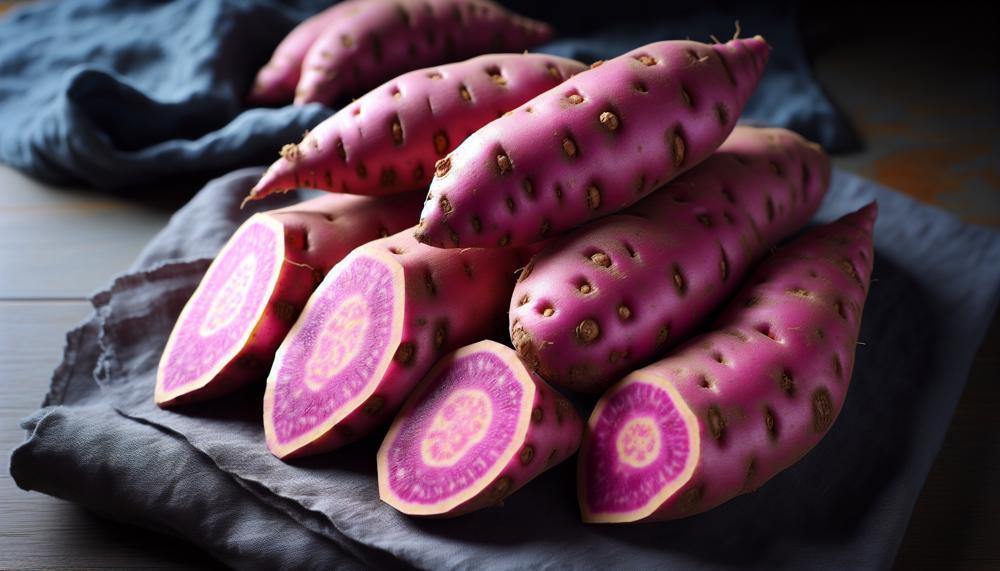Have you ever eagerly reached for a sweet potato, only to be met with a rancid smell or a mushy texture?
Or perhaps you’ve taken a bite of what looked like a perfect sweet potato, only to discover an unpleasant taste. We’ve all been there – the frustration and disappointment of dealing with spoiled produce.
So, how to tell if a sweet potato is bad?
Here are some signs that a sweet potato has gone bad:
- Softness: A fresh sweet potato is firm, while a bad one will be mushy.
- Discoloration: A bad sweet potato may have black, green, or white spots on the skin.
- Sprouts: A bad sweet potato may have stalky purplish sprouts.
- Smell: A bad sweet potato may smell rotten.
- Other signs: A bad sweet potato may also have shriveled skin, be oozing, or leak juices.
If a sweet potato is still firm and only has a few sprouts, you can cut off the sprouted part and cook it right away.
Whether you’re a seasoned cook or just starting out in the kitchen, keep reading to become an expert in spotting spoiled sweet potatoes and never waste another one again.
Contents
Why Do Sweet Potatoes Go Bad?
Sweet potatoes can become unsafe and spoil due to a variety of factors, including environmental conditions, physical damage, and microbial growth. These factors can cause the sweet potato to deteriorate, leading to a loss of quality and potential illness if consumed. Therefore, it is essential to store sweet potatoes correctly and be aware of possible causes of spoilage.
Environmental conditions are a significant contributing factor to the spoilage of sweet potatoes. Exposure to extreme temperatures and high humidity levels can cause mold growth on the skin, which can then spread to the flesh, making it inedible. As a result, sweet potatoes should be stored in a cool, dry place away from direct sunlight.
Physical damage is another common cause of sweet potato spoilage. Bruising or cutting the skin of a sweet potato can create an entry point for bacteria and fungi to enter and grow, speeding up the oxidation process and causing the sweet potato to turn brown and eventually spoil. To prevent this, make sure to handle sweet potatoes with care and inspect them regularly for any signs of damage.
Microbial growth is perhaps the most significant factor in sweet potato spoilage. Bacteria and fungi can quickly multiply on the surface of a sweet potato, particularly if it has been damaged or is in an environment with high humidity. Mold is a common issue on sweet potatoes and can be identified by its fuzzy appearance on the skin. Bacteria such as Salmonella and E.coli can also grow on sweet potatoes, causing food poisoning if consumed.
To keep your sweet potatoes fresh and safe to eat for as long as possible, proper storage is crucial. This includes keeping them in a cool, dry place away from direct sunlight and regularly inspecting them for any signs of damage or mold.
How To Tell if a Sweet Potato is Bad
Inspect for mold or discolored spots
Any signs of mold or dark, unusual spots on the skin of a sweet potato may suggest spoilage and the presence of harmful bacteria.
Err on the side of caution and discard it.
Smell for a sour or funky odor
A fresh sweet potato should have a gentle, earthy aroma.
If you detect a sour or pungent smell, it could indicate bacterial growth and the sweet potato should not be consumed.
Feel for a soft, mushy, or spongy texture
A new sweet potato should feel solid and have a smooth texture.
If it feels soft, mushy, or spongy, it is likely spoiled and should not be eaten.

Look for sprouts longer than an inch
While small sprouts are normal on sweet potatoes, longer ones (over an inch) may signify that the sweet potato is past its prime.
These sprouts can also give the sweet potato a bitter taste.
Check for shriveling or loss of moisture
A healthy sweet potato should be dry, smooth, and weighty. If it appears shriveled up or feels light in weight, it may be past its prime and could pose a safety risk if consumed.
When in doubt, it’s best to toss out the sweet potato rather than risking food poisoning. Proper storage and handling can also help prevent spoilage and extend the shelf life of sweet potatoes.
Store them in a cool, dry place away from direct sunlight and avoid plastic bags as they can trap moisture and promote bacterial growth.
How to Store Sweet Potatoes
For optimal storage of sweet potatoes, it is crucial to follow these important steps:
- Cure the sweet potatoes: After harvesting, allow the sweet potatoes to dry for 10-14 days in a warm and humid location. This process, known as curing, toughens the skins and converts starches into sugars, resulting in a sweeter flavor.
- Find ideal conditions: Curing at 80-85 F (26-29 C) with 80% humidity is ideal. If curing indoors, store near a furnace or in a warm indoor location for 2 weeks.
- Pack and preserve: Once cured, remove any remaining dirt and pack the sweet potatoes in paper boxes or wrap them in newspaper. Store them in a cool pantry or closet at 55-60 F (12-15 C).
- Regularly check for mold: Keep an eye on the sweet potatoes for any signs of mold and promptly remove any affected ones.
- Avoid refrigeration: Cold temperatures can harm sweet potatoes, so avoid storing them in the refrigerator for more than a few days.
Other storage techniques include banking, where tubers are stacked in straw-covered circular beds with ventilation and protection from moisture, or storing them in sand-packed barrels or crates in a warm basement or garage. However, make sure to avoid storing sweet potatoes in sand without proper ventilation.
Can You Freeze Sweet Potatoes?
Absolutely. And the freezing method varies depending on how you plan to use them in the future. Here are some helpful tips for freezing sweet potatoes:
- Begin with fresh sweet potatoes: Ensure that your sweet potatoes are fresh and in good condition before freezing.
- Properly prepare them: Peel and chop the sweet potatoes into evenly-sized pieces for easier freezing and thawing.
- Choose your preferred freezing method: The method you choose depends on how you plan to use the sweet potatoes later. For cubed or wedged sweet potatoes, blanch them in boiling water for 3-5 minutes before freezing. This helps maintain their texture and crispiness. For fries, blanch them first before freezing in a single layer on a baking sheet.
- Freeze mashed sweet potatoes: You can also freeze mashed sweet potatoes by adding seasonings and cream before allowing them to cool completely and storing in freezer bags or ice cube trays for convenient portioning.
- Avoid freezing raw sweet potatoes: It is not recommended to freeze raw sweet potatoes as they have high water content and are prone to freezer burn.
- Store frozen sweet potatoes properly: To prevent freezer burn, store the frozen sweet potatoes in airtight containers or bags. When ready to use, thaw slowly in the refrigerator.
- Consume within 8-12 months: While frozen sweet potatoes can be safely stored for up to 8-12 months, it is best to use them within 3-6 months for optimal taste and texture.
Guide for Storing Sweet Potatoes in the Fridge/Freezer:
| Fridge Storage | Freezer Storage | |
| Sweet Potatoes (fresh) | 5-7 days | 8-12 months |
| Cubed/Wedged Sweet Potatoes | Not recommended | 8-12 months |
| Mashed Sweet Potatoes | 5-7 days | 8-12 months |
| Sweet Potato Fries | Not recommended | 8-12 months |
By following these strategies, you can safely freeze sweet potatoes and incorporate them into a variety of dishes all year long.
Related Posts:
Sweet potatoes are an incredibly nutritious and versatile vegetable, but just like any food, they’re susceptible to spoiling if not stored or handled correctly. Here are some common indications and signs that a sweet potato may not be safe to eat:
- Soft or spongy spots: If you observe any soft or spongy spots on your sweet potato, it might be an indication of bacterial or fungal growth. These spots may also have an unpleasant odor and may be discolored.
- Mold: Mold is a clear sign that your sweet potato has spoiled. It can appear as fuzzy green, black, or white patches on the skin or flesh of the potato.
- Shriveling: Sweet potatoes should have smooth and firm skin. If you notice that your sweet potato has shriveled skin, it could be a sign that it has dried out and is no longer safe to eat.
- Strange smells or textures: If your sweet potato has an unusual smell or texture, it’s best to discard it. This could be a sign of spoilage or contamination.
It’s essential to note that these indicators may not always be present, and it’s always best to use your own judgement when deciding if a sweet potato is still safe to consume. When in doubt, it’s better to throw it away.
Also Read: Does Kraft Mac & Cheese Go Bad?
Conclusion
In summary, being able to recognize spoiled sweet potatoes is crucial in preventing both food waste and potential illness.
Factors such as environmental conditions, physical damage, and microbial growth can all contribute to the spoilage of sweet potatoes. However, proper storage and handling techniques can greatly reduce the risk of spoilage.
When inspecting sweet potatoes for signs of spoilage, be on the lookout for mold or discolored spots, take note of any sour odors, feel for a soft texture, and check for sprouts longer than an inch. To ensure that your sweet potatoes stay fresh and safe to eat, store them in a cool, dry place away from direct sunlight and avoid using plastic bags.
Above all else, trust your own judgement when determining if a sweet potato is still suitable for consumption.




